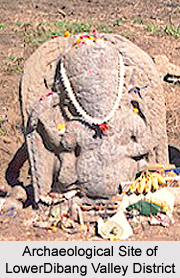 History of Lower Dibang Valley district involves several administrative and political changes that resulted in the formation of this district. The name of this district is derived from the Dibang River that flows through the heart of district and finally ends into the Brahmaputra River. Prior to the year 1914, the Lower Dibang Valley district of the state of Arunachal Pradesh was a part of Lakhimpur district of Assam. By the year 1914, the North East Frontier Tract was formed with three political charges and the region covered by the Lower Dibang Valley district became a part of the Eastern Section. In 1919, the Central and Eastern Section came to be known as the Sadiya Frontier Tract.
History of Lower Dibang Valley district involves several administrative and political changes that resulted in the formation of this district. The name of this district is derived from the Dibang River that flows through the heart of district and finally ends into the Brahmaputra River. Prior to the year 1914, the Lower Dibang Valley district of the state of Arunachal Pradesh was a part of Lakhimpur district of Assam. By the year 1914, the North East Frontier Tract was formed with three political charges and the region covered by the Lower Dibang Valley district became a part of the Eastern Section. In 1919, the Central and Eastern Section came to be known as the Sadiya Frontier Tract.
In the year 1943, some of the areas from both the Sadiya Frontier Tract and the Lakhimpur Frontier Tract were carved out and in this way Tirap Frontier Tract was created. Under the North East Frontier Tracts (Internal Administration) Regulation, 1948, the remaining segment on the Sadiya Frontier Tract was bifurcated into two separate administrative charges, which are mainly the Abor Hills district and the Mishmi Hills district and each of these in the charge of a political officer with their headquarters at Pasighat and Sadiya correspondingly. Further, in the year 1951, the plains section of the Mishmi Hills district was shifted to administrative authority of the state Government of Assam. Again in 1952, the headquarters of the Mishmi Hills district was transferred from Sadiya to Tezu.
The history of Lower Dibang Valley district elaborates the series of political and administrative changes that lead to the formation of this district. As per the North East Frontier, areas (Administration) Regulation 1954, the North-East Frontier Tract came to be known as North-East Frontier Agency. Further, under this regulation, the Mishmi Hills district was renamed as Lohit Frontier Division. In the year 1956, the Dibang Valley was composed as a distinct administrative unit within this particular division and thus it was placed under the in charge of Additional Political Officer with Roing as headquarters that was subsequently shifted to Anini. Under the North-East Frontier Agency (Administration) Regulation, 1956 the Lohit Frontier Division was renamed as Lohit District (its present name) and the in charge Political Officer and Additional Political Officer were re-selected as the Deputy Commissioner and Additional Deputy Commissioner in that order.
Moreover, under the Arunachal Pradesh Re-organization of district Act 1980 the Lohit District was separated into two independent districts namely Lohit District and Dibang Valley District, with their headquarters at Tezu and Anini respectively. According to the Amendment of Re-organization of the District Act of 1980, the Lower Dibang Valley district was formed out of the un-divided Dibang Valley district with its headquarters at Roing.



















